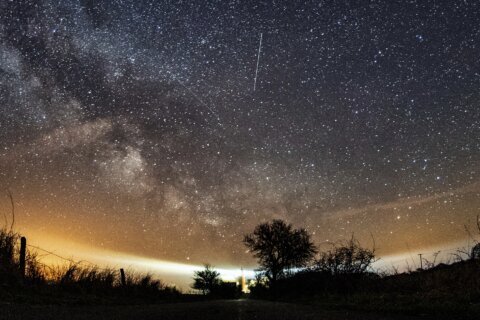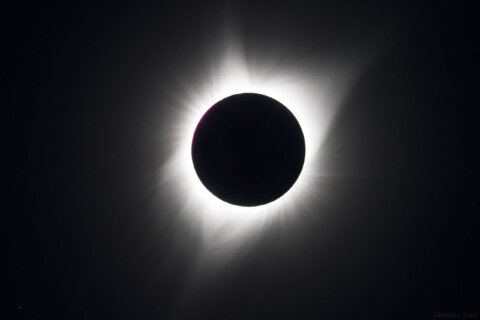▶ Watch Video: Fireflies put on a summertime light show
Fireflies are the romantics of the insect world. In the summer months, they emerge from the ground with love on the brain. They only live for two to three weeks once they’ve become full adults and in that time they don’t even eat. They’re too busy flirting.
Fireflies — or lightning bugs, depending on where you grew up — are one of the only insects with elaborate courtship dialogues, said Avalon Owens, a research fellow at Harvard.
Male fireflies fly around and a part of their abdomen called a lantern will “light up in a little advertisement, like a billboard,” per Owens. Then females sitting on the ground look up at the display and flash back to the males they decide they like.
“This is the precursor to meetings,” Owens said. “So they’re not going to mate unless they’ve had this little dance where they’ve exchanged these light signals.”
Different firefly species have performed variations of that light dance for millions of years, lit only by the moon.
Now artificial lights are killing their mood.
Humans have been acting like buzzkills, turning on the overhead lights at the fireflies’ summer party with street lamps, floodlights and LEDs.
Drowning in the lights
In the firefly world, it’s the females who are particularly turned off by artificial light.
Owens led studies in experimental conditions and field conditions and found that male fireflies often keep flashing under street lamps and other kinds of overhead light, while nocturnal female fireflies essentially shut down and stop responding.
“Probably because they just can’t see the males very well,” Owens explained. “Typically male fireflies are looking down. Female fireflies are looking up at street lights and other light sources.”
In lab conditions, not one of 20 pairs mated successfully under bright lights, while about half of firefly couples mated successfully in natural twilight.
In the last decade, the night sky became twice as bright due to the increasing use of LEDs, Owens said, which hurts the populations of nocturnal fireflies.
But if you haven’t noticed the impact on fireflies in your area, it might be because not all fireflies are nocturnal. Some of the most common fireflies come out before dusk and function under bright lights perfectly well.
For example, if you caught a firefly as a kid, chances are it was a Big Dipper firefly — named because the males dip as they flash, drawing “J”s in the air to attract females. In summer months, that species sparkles over the eastern half of the U.S. from Texas to New York, where it flies around even in well-lit parts of Central Park.
A room of candles winking out
But plenty of firefly species are under threat — particularly ones that thrive in disappearing habitats or nocturnal species that evolved to mate in complete darkness.
Certain species of fireflies are struggling in Mid-Atlantic states and in the South where drought exacerbated by climate change has hit fireflies native to Arizona and Texas, said Sara Lewis, author of “Silent Sparks: The Wondrous World of Fireflies.”
“I like people to think about firefly extinctions as sitting in a room of candles, and it’s beautiful,” said Lewis, a professor of biology at Tufts. “And if one or two of those candles gets extinguished, you probably don’t even notice it, but if that continues, eventually you are left sitting in complete darkness.”
Eighteen firefly species found in the U.S. and Canada are classified as threatened, meaning scientists have determined they are at high risk of extinction within the next 10 years or so, according to a recent comprehensive assessment. And that number may be an undercount. Researchers didn’t have enough data to pinpoint the risk to many of the species, but they estimated nearly 1 in 3 of the 170 firefly species in North America are threatened with extinction.
Currently, no fireflies are protected under the Endangered Species Act. But scientists have petitioned for federal protection for a handful of species.
One of them is the Bethany Beach firefly, which went from being found in saltwater marshes up and down the Atlantic coast to living in only half a dozen state parks after their beachside habitats were replaced with vacation homes or condos.
Mysterious Lantern Fireflies, which flash in long pulses — glowing like orbs over swampy bogs in the Mid-Atlantic — have also been disappearing.
And Arizona’s Southwest Synchronous Firefly numbers among the vulnerable species, meaning there might be only a few more showings of their remarkable light display where the males of that species sync up their courtship flashes.
How to foster fireflies
Anyone who wants to help fireflies should know they have a backstory, said Lewis.
“It’s not just those ethereal adults that are lighting up the night,” said Lewis. “Eighty percent of their life is spent living underground in a juvenile stage.”
Fireflies live two years underground as larvae — which also glow — feeding on worms and slugs that thrive in wilder, natural spaces before metamorphosing into the winged creatures we know and love.
People who want to foster fireflies in their spaces could start by leaving a few leaves in the yard for the larvae to live under, said Candace Fallon, a senior conservation biologist at the insect conservation group Xerxes.
“It’s just keeping things a little unkempt for them,” said Fallon. “So whether that’s not mowing a certain section or mowing infrequently. Maintaining native grass and tree cover and shrubs.”
Pesticide use is another big threat to the juvenile firefly population, which conservationists push to limit.
Then, of course, there’s turning off the lights. Buying curtains or motion-activated porch lights would help keep nights dark enough to preserve fireflies as a distinct source of summer wonder.
“You have increasing distractions and screen time and all of these kind of indoor marvels that people get excited about,” said Fallon. “I think fireflies are like starting to be one of these last few things that really pull people outside at night. There seems to be a universal joy and love of the species.”







